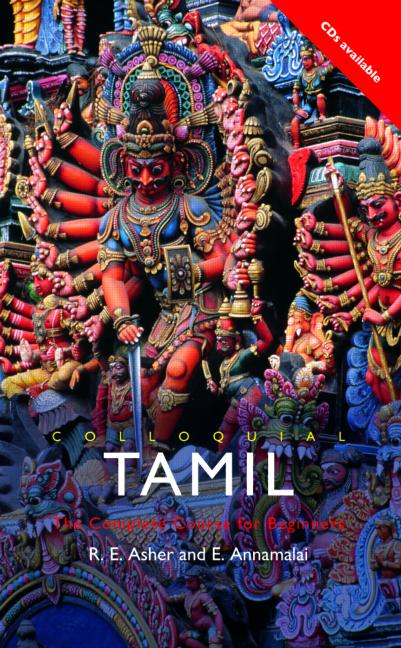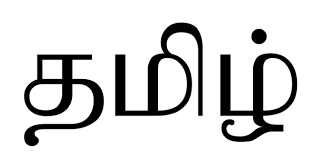Update - July 20, 2023
I've written two more blog posts on the topic of Colloquial Tamil. The first is an update to this post with a few additional learning resources I've found as well as published Anki decks. The second is a guide on how to read and pronounce the Tamil script, and transliterate it using Python.
With the first semester of my PhD finally complete, I now have a few weeks of winter break before my classes start again at the end of January. To fill up my time, I've decided to try and pick up Tamil. In this post, I'll go over some of the resources that I've found (and created) to help me learn.
For anybody unfamiliar with Tamil, it's very important to understand the Tamil exhibits a strong sense of Diglossia, meaning that there is a formal, prestige dialect, and an informal, vernacular dialect. These two forms can be quite different, both in grammar and vocabulary. Nearly all written Tamil material uses formal Tamil, while most spoken Tamil uses the colloquial version. This presents a problem for me, since I'm not really interested in learning formal Tamil at all, but most learning material focuses on it.
Thankfully, I've found a few sources that teach colloquial Tamil. The first is UPenn's Tamil Language in Context site which teaches both formal and colloquial Tamil side-by-side. This site is decent, and it's one I've used in the past, though mainly for vocab. However, the site is very dated (last updated in 1998!), and not very friendly to use and navigate between various sections and lessons.

The second resource I found is the book Colloquial Tamil, which is available online at archive.org. This book was published in 2003 so it's pretty old as well, but it doesn't matter as much since it's just a simple PDF, and not a website "best viewed with 600 X 800 pixels".
The main reason I prefer Colloquial Tamil is because I think it goes through the material in a better order, and is more useful for learners, since the book contains exercises, practice dialogues, and an explanation of grammar which is more suitable for beginners.
However, one significant change is that Colloquial Tamil uses a romanized transliteration of Tamil instead of the natural Tamil script. I've taught myself to read the Tamil script, but I must admit that the transliteration is still easier and faster for me to read. The book does attempt to teach the script along the way, but it can be completely ignored. The transliteration marks retroflex consonants using ʈ/ɖ/ɳ/ɭ, while not distinguishing between the various characters for "n" which aren't distinguishable in modern spoken Tamil. There were a few places where I disagreed with the book's chosen transliteration (e.g. "ippa" instead of "ippo" for the English "here"), but it was pretty usable overall.
Over the last week, I read through the entire book, and took notes on the grammatical concepts that the book introduces. I have very little knowledge of spoken Tamil grammar, so it was very fun to go through the book and learn about just how different Tamil and English grammar is (so many suffixes!). I've made all of my notes available here. I also created a table of verb forms that the book mentions here, though this was mostly just for fun.
As a side note, I've set up hotkeys to map "t-x" to to "ʈ" (same for the other retroflex consonants) using BetterTouchTool, and I'd definitely recommend this approach to others. Back in high school when I was learning Esperanto, I used a dedicated app called Tajpi to type the Esperanto diacritics, but BTT is a better approach since I have complete control over the hotkeys.
After finishing all of the grammar lessons, the next step was to start learning vocab. To do this, I've created two Anki decks. The first contains all of the non-verb words in the book. The second contains all of the verbs from the book, but with the twist that I actually have three cards for each verb - past, present, and future tenses. This is because nearly all Tamil verbs completely regular given that you know the past and present tense, but these two forms are not deterministic. I added the future tense as well just because it should increase my speaking speed.
Hopefully these links, notes ,and Anki decks are useful for anybody else interested in learning colloquial Tamil!



3 Comments
Jon · September 20, 2021 at 9:18am
I’ll be in Tamil Nadu for the next several months (Thiruvallur & Sengadu, mostly). Am hoping I can wrap my English tongue around the wild and unbridled Tamil-talk!
estas interese lerni, ke vi iam eklernis Esperanton—vi verŝajne ankoraŭ tion parolas, ĉu ne? 😉
Sowmya · November 24, 2021 at 10:44am
Hey! This was helpful! Also, would you mind sharing your Anki Decks? Thanks!
Morgan · November 29, 2021 at 12:45pm
Can I have access to you Anki decks if possible?